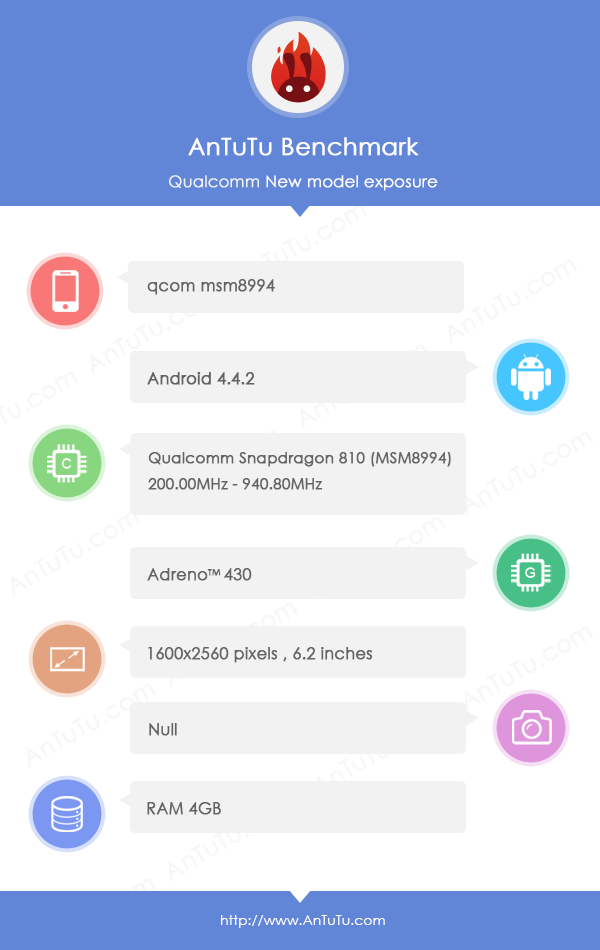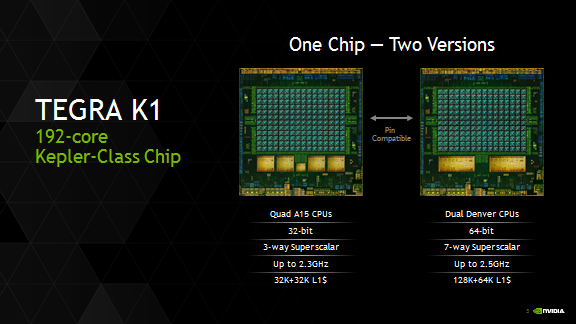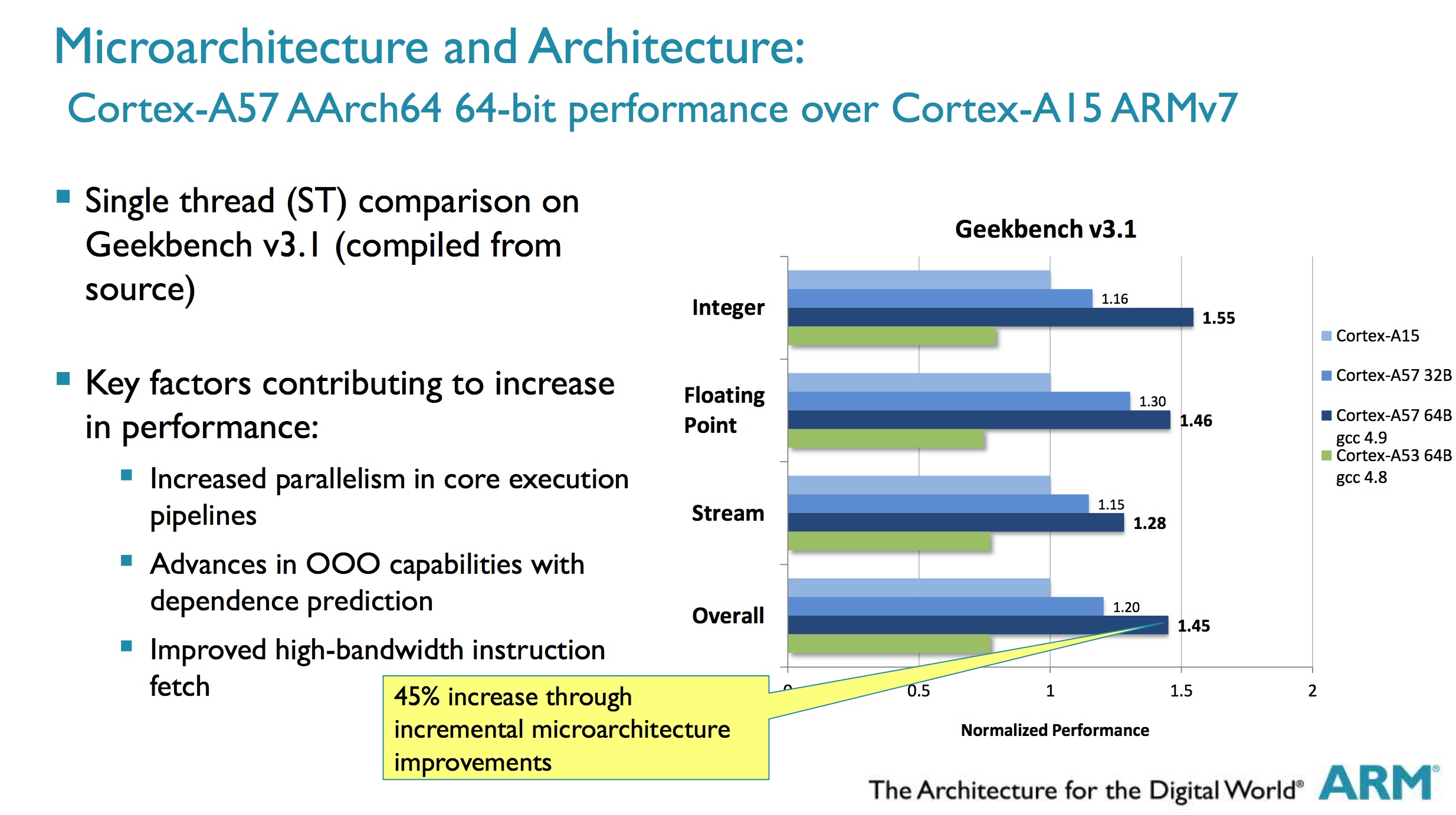Qualcomm Snapdragon 810 (Cortex A57) Appears In Benchmark
Hints about new processors or device specs keep popping up from AnTuTu benchmarks these days. The latest important product to be exposed this time is Qualcomm’s upcoming ARMv8-based (64-bit) Snapdragon 810 SoC.
The chip appears to power a device that is 6.2” and has a resolution of 2560x1600 (typically a tablet resolution, as smartphones tend to have 2560x1440). The device also has 4GB of RAM, which is something we should expect on all 64-bit high-end devices later this year and next year, too. The new ARMv8 ISA brings many performance improvements along with 64-bit support, which makes it easy for devices to support 4GB of RAM or more.
When Apple announced its A7 chip last year, it appeared that Qualcomm wasn't expecting an ARMv8-based chip from Cupertino. Qualcomm buys ARM’s architecture licenses in order to build its own custom cores for the high-end, but it didn't this time around, and it still doesn’t look like Qualcomm is going to announce any ARMv8 proprietary core any time soon even a year after Apple’s announcement.
It also appears that Qualcomm intends to use Cortex A53 at the low end (such as in the Snapdragon 410) and Cortex A57 at the high-end (such as in Snapdragon 810) as a stopgap solution until it releases its own ARMv8 successor to the Krait core.
It’s likely we won’t see such a successor until late 2015 at the very earliest. It’s also possible Qualcomm wasn’t building a next-gen core that’s as large and wide as Apple’s A7 (6-way wide) and Nvidia’s Denver (7-way wide), but more in line with ARM’s Cortex A57, which is only 3-way wide.
If that’s the case, then Qualcomm must’ve gone back to the drawing board, and we won’t be seeing a custom core from it until sometime in 2016, as it usually takes at least 2 years to design a new core. Until then Qualcomm would keep using Cortex A57 in its high-end CPUs, which is unlikely to be competitive enough against Nvidia’s Denver and Apple’s A8.
Cortex A57 at 20nm brings about a 45 percent improvement over Cortex A15 at 28nm in part because of the new process and in part because of the new ARMv8 instruction set, as you can see in the image below. However, Nvidia's Denver should be about 25 percent faster than that (80 percent faster than Cortex A15), even at 28nm.
Get Tom's Hardware's best news and in-depth reviews, straight to your inbox.
It doesn’t seem that Qualcomm’s GPUs have increased in performance that much either, since the latest Adreno 330. Adreno 420 is only supposed to get a 40 percent increase in performance, which isn’t nearly enough to catch up to Nvidia’s Kepler GPU, and Adreno 430, which will be in this Snapdragon 810 chip, is supposed to be only 30 percent faster than Adreno 420.
Perhaps its reign at the top of the mobile chip market over the past few years has made Qualcomm slower and less responsive to the competition. However, something will need to change, or it’s only a matter of time before most consumers notice, too. Then they will start demanding that their devices don’t come with Snapdragon processors anymore. At that point device makers will have to listen those demands, despite the great relationships with Qualcomm that they’ve fostered over the past few years, and switch to the competition’s chips.
Follow us @tomshardware, on Facebook and on Google+.
Lucian Armasu is a Contributing Writer for Tom's Hardware US. He covers software news and the issues surrounding privacy and security.
-
InvalidError Or perhaps it is Qualcomm simply realizing that there is no point in this resolution insanity on 4-6" devices with 2-3Ah batteries and putting the brakes on that train wreck. Intel and Samsung are on that same path too: heavily favoring low power over performance.Reply
Considering how uncomfortably hot just about every phone and tablets become after a few minutes of running games, I would be far more interested in halving SoC power than doubling performance. -
Mike Friesen Intel favoring low power over performance? In the SoC (tablet + phone) field, that's simply not true. Broadwell Y (Intel core M) is designed to fit into fanless tablets, yes they focused on low power for intel core, but getting Intel core into tablets provides a ~50% performance increase over the already powerful z3770, with more than double the graphics performance, and roughly the same power envelope (both atom and core now fanless). I mean, you're technically correct in that intel has gone lower power on it's desktop and notebook cpu's, but the tablet/smartphone space is still seeing rapid growth in performance.Reply -
TheSecondPower Qualcomm processors seem to have a good balance of performance and battery life (and cool temperatures), along with competitive prices, which I would think is why most phones have Qualcomm processors and almost none (or none at all?) have Nvidia processors. I think Qualcomm's problem is that they're making good processors instead of processors that sound good after a marketting team gets through with them. People think they want 8-core phone processors and 2560x1440 screen resolutions. I don't think Qualcomm was expecting 64-bit phone processors to also become a fad in 2014. Why would phones need 4GB of RAM? It only takes 2GB to run Windows 7 without problems (obviously more is beneficial, but beyond gaming it's not needed for much that most consumers do). I don't think Qualcomm is falling behind, they're just basing their decisions on real-world performance instead of marketing, and they're selling to more than just the super-high-end smartphone market.Reply -
hannibal I also expect to see some power-usage competition in the future also in mobile segment. More speed is good in mobile sector also, but we are getting quite near the situation that most people have mobile CPU fast enough for everything they need. Of course there are peoples and applications that can always use more power, but I by self have been looking how long device can operate with one charge for a some time.Reply
Bun one thing is that Qualcomn is also a late. No excuses in there. The 64bit architecture can bring more speed with less electricity, so in the short run it is much more useful that having eight cores or 2560*1440 screen in mobile phone.
I really hope to see a smart phone with 64bit processor and 2 week usage time... But I have to wait many years for that to happen, I hope that it is possible though. -
InvalidError Reply
Even if you eliminated RAM and CPU/GPU power usage altogether, the display would still run the battery dry in less than 24h worth of continuous use since the display is the second biggest power hog after the SoC when running CPU/IGP-intensive stuff.13965447 said:I really hope to see a smart phone with 64bit processor and 2 week usage time...
-
joaompp Aren't these benchmarks pointless? Devices with new SoC will all be using Android 5 which uses a very different compiler than DalvikReply -
ericburnby ARMs A57 cores aren't even as fast as Apple's A7 cores, and they are already a year old. Not very impressive when your first processor is already outdone by an 18 month old design (by the time the 810 actually ships, which Qualcomm says is early 2015).Reply
And we have the A8 due out very shortly. Apple has doubled performance every year for 3 versions of their processors. If they double again for the A8, then nothing Qualcomm or Samsung has will even come close. -
hahmed330 ReplyOr perhaps it is Qualcomm simply realizing that there is no point in this resolution insanity on 4-6" devices with 2-3Ah batteries and putting the brakes on that train wreck. Intel and Samsung are on that same path too: heavily favoring low power over performance.
Considering how uncomfortably hot just about every phone and tablets become after a few minutes of running games, I would be far more interested in halving SoC power than doubling performance.
If you have higher performance then you can scale that down trade performance for power savings. So henceforth higher performance can also means longer battery life. On the other hand display is a power hog so more then 1080p resolution is just not necessary on less then 5 inch displays.


